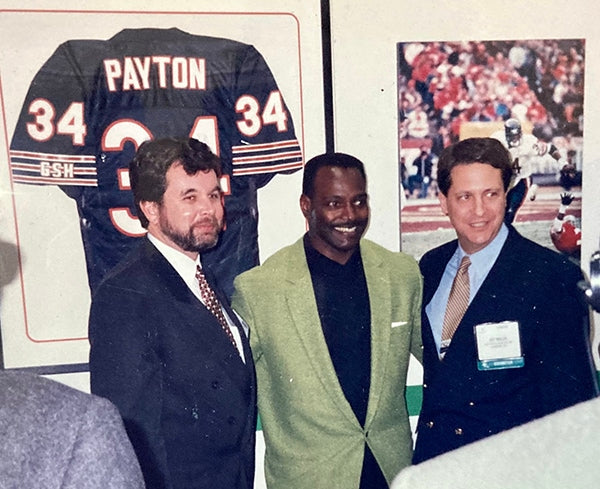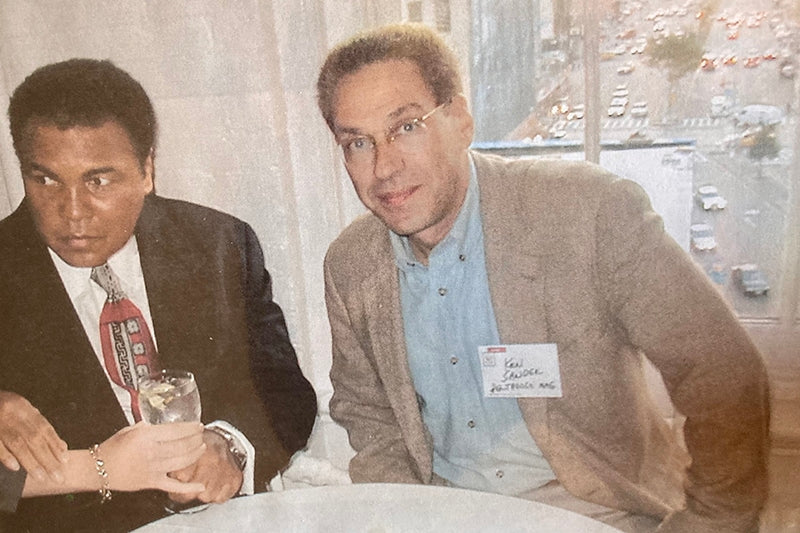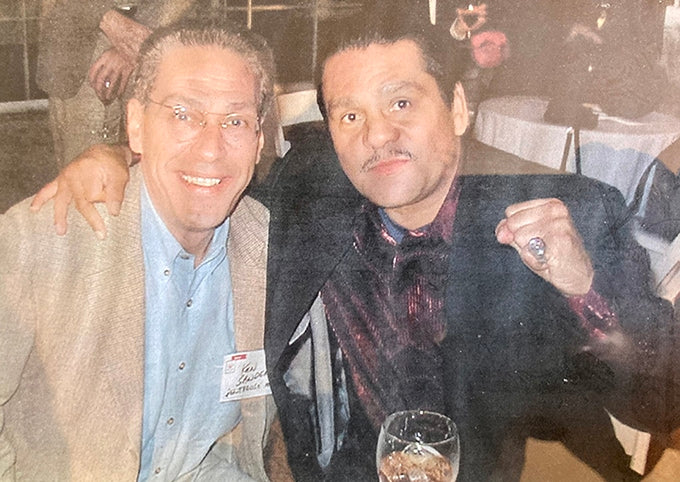The Cable Doctor Show started modestly as a live TV call-in question and answer show on tech and installation issues. Of the three TV programs I’ve hosted, this one was my longest-running public access (and at times leased-access) television show. It was on the air for over 14 years. The brand, via media and my Cable Doctor retail business, was active for almost 30 years. Starting in the late 1980s, the show aired into the early next century. We had many different approaches, kinda like seasons if you will.
At one point we were on satellite, reportedly covering one-third of the world. We broadcasted live from our 23rd Street studio with a feed to Manhattan Cable next door. Then the show was beamed up to a live satellite, then fed to Denver and relayed to a satellite transponder, and out to North America and Canada, Hawaii, and the Caribbean.
Remember those tremendous satellite dishes on people’s front lawns? Those were C-Band satellite dishes. They were monsters really. The video quality was decent, but the programming was a lot of public access or UHF low-powered broadcasts. One time on a live show I received a call from Hawaii, and others from Calgary and the US Virgin Islands.
The cost for the satellite uplink was $750, and then studio and other expenses. Even with a sponsor, the cash outlay was significant. At least to me, and then there was the long-term viability of C-Band to be considered. At the time, RCA had recently released a digital satellite TV system. It was a small dish approximately the size of a pizza tray and was able to receive commercial cable television programming. These new systems took off, thus putting C-Band into decline.

From the not-so-old days of broadcasting: a C-Band satellite dish. Courtesy of Wikimedia Commons/Vsatinet.
Working the phone. I was cold-calling companies like Blockbuster Video and Philips, looking for sponsors. This usually entailed patience on my part. If I was lucky that meant having my call getting transferred all over a company’s phone system in search of the person who oversaw company advertising. One time, I wound up talking to someone who was an executive at Philips North America’s media relations. He could not commit to anything, but he had a spokesperson on a media tour for Philips’ MiniDisc player. His thinking was that a related slot on my show might bring me to the attention of the company, and thus making me a known quantity to Philips. I agreed, and a few weeks later Ron Goldberg, a consumer electronic journalist (now founder and chief product officer at digital health company Motum), would appear on The Cable Doctor Show.
I had the practice of scheduling my on-air guests to arrive to an hour before we went on the air. That served multiple purposes. One was to get the guest comfortable with the environment, and to go over their segment.
Ron and I hit it off and we found out that we’d met before. When I was on tour with the rock band Renaissance about 15 years earlier (see my article in Issue 123), he was on the concert committee that booked them. We had met briefly backstage. He asked if I was going to the upcoming Consumer Electronics Show in Las Vegas. This was in the early 1990s. I did not know about the trade show and Ron filled me in. It sounded great; I could tape interviews and show products. This looked like it might be a good opportunity to expand The Cable Doctor Show’s content.
Registration for the media/press was not a problem. I was certified as a media attendee. Ron and his friend, consumer electronics writer Stewart Wolpin were staying at Circus Circus and they made a reservation for me. The Consumer Electronics Show (CES) happens in early January each year. (There used to be a Summer CES in Chicago but those stopped after 1994.) Being my first time attending, I had to make decisions about what I would cover, without any facts or knowledge about the show. I had no idea of what to expect. My thinking was that I could arrive on the second day of CES and be able to easily cover it. This was wrong, of course. I had no knowledge of the dedicated press day that took place before the show, or the opportunities to schedule individual meetings with company representatives. I was an unknown, so nobody was looking for appointments with me. I had no idea how big the show was.
When I first walked onto the convention floor it was overwhelming. The Las Vegas Convention Center’s Central Hall is tremendous. Hundreds of booths and displays; it seemed like every consumer electronics company in the world was represented there.

Things can get crowded at trade shows at the Las Vegas Convention Center. Courtesy of Wikimedia Commons/Pattymooney.
Later that evening I met up with Ron, Stewart Wolpin, and syndicated columnist Harry Somerfield’s at an RCA press conference. They made me feel welcome.
At that point in time my service center (repair shop) was open and doing business. We were sitting around a big table having drinks and chatting after the RCA press event and someone asked me about VCR repair. After giving an explanation of why a VCR would eat a tape, I remembered one of my technician’s workspaces. I was telling the table about how I noticed a glass on his bench area that was three-quarters filled with little screws. When I saw that, I realized there were a lot of VCRs around the city that were missing screws. Everyone at the table cracked up. In truth, I told the tech that going forward, all screws must be reinstalled! And I kept an eye on the glass to make sure it never got any fuller.
The next day I met up with my new friends as they covered the high-end audio exhibits, which, in the 1980s and 1990s, were located in places like the Las Vegas Jockey Club, the Sahara, Alexis Park, and other locations away from the Convention Center. This was a gas. Walking in and out of the exhibit rooms (which were rearranged hotel rooms) was very cool and I started to get a feel of how much fun the show could be. That night we split up. The others had dinners with manufacturers’ press people scheduled and I did not. The following day I walked the Convention Center floor. At the time (the early 1990s), CES was only located in the Central North Halls (the Convention Center has since expanded significantly) and some off-site venues where high-end audio manufacturers exhibited. Still, it was overwhelming. So much energy and so many attractions.

Memory lane: a hallway at the Alexis Park Hotel, Las Vegas, where the high-end exhibitors used to be located. Courtesy of Wikimedia Commons/Linux Journal.
Being with some of the highest echelon of the industry’s press was a great intro. I knew nobody at first, but at the press conferences I met other journalists and editors. Ron, Harry, and Stewart were industry veterans, experienced media people, and they knew everyone. Better yet, they talked about The Cable Doctor Show in glowing terms, and it really helped to legitimize me to the press corps.
One of my new friends was Brent Butterworth. Brent, an audio journalist and consultant to this day, mentioned that he was interested in collaborating with me on The Cable Doctor Show. At the time Brett was one of the editors of Video magazine. The other two editors were the late Jim Barry, and Stan Pinkwas (still working as an editor). The magazine was located at 460 West 34th Street, a big industrial building on the southeast corner of 10thAvenue. Video occupied two floors. The top floor was editorial, and the floor below was for testing and reviewing products. Lancelot Braithwaite ran that department. Lance is a legend in the industry.
We were going to tape The Cable Doctor Show at the magazine’s office every Monday evening. I would bring Chinese takeout for the three of us. I would show up after 6:00-ish when the offices were empty or emptying out. We would put together a makeshift studio on the floor we were going to use that evening. It could be torn down after the taping.
With production improved and my costs mostly evaporated, the show moved on to this new format. Lance was a voice of authority on new products and a welcome addition on many segments. We had guests; turntable expert Michael Fremer (The Absolute Sound, The Tracking Angle) did a show on high-end audio.
We tried different things. We wanted to do some call-ins, but we were not live. Brent thought we could fake it, so we set up a phone and he simulated a call. I had no idea what he was going to ask me. So, I picked up the phone and in a weird voice Brent said, “Cable Doctor, I have some schmutz in my viewfinder on my video camera. How can I clean it off?” Trying hard to keep a straight face, I explained how to detach the viewfinder and clean the glass. We both decided that the phone simulation was too corny, and it was abandoned. To this day it is still a standing joke between us. A year or so later, Brent had taken a new job at CurtCo Media in Malibu, California. At the time they were the publisher of Home Theater Technology and the Robb Report. That meant his relocation to the West Coast and the end to our collaboration on the show.
By then I was covering consumer electronics events regularly. Press conferences and product announcements. I would tape part of the proceedings and interview the media spokesperson or whatever celebrity they hired. Slowly, over time, the companies and public relations firms accepted me as a legit journalist. However, although I was invited to press conferences, it was a few more years till companies and their PR reps accepted The Cable Doctor Show enough for me to get product loans and the use of review samples. The consumer electronics reporters and press treated me like an equal from the get-go.
At a Dragon Systems press event I met Richard Dreyfuss. I asked him why he was helping promote their voice-activated typing program (Dragon is now offered by Nuance) and he told me that a close family member had a disability that necessitated having to use voice control rather than hands-on typing, making his interest in that technology personal. At a Sprint event at the Supper Club in Manhattan, magician David Blaine joined us for an hour or so after he did an amazing show where he sat underwater drinking red wine and reading a newspaper. I still have no idea how he did it. Athletes were also were hired for meet and greet press events. Walter Payton was at a Fuji event. Joe Theismann seemed thrilled to meet me, but Boomer Esiason was lukewarm. Dan Marino spent a good 10 minutes joking with me at a Samsung event. He told me that they gave him flat-screen TVs for every room in his southern Florida mansion.

Walter Payton (center) with Fuji executives.

Joe Theismann and Ken Sander.
At the last Summer CES in Chicago, I was interviewing boxer Riddick Bowe. He was admiring my Sharp LCD camcorder that I had on a one-month loan. That camera was a breakthrough for Sharp, with its 8-inch LCD screen. The camera was revolutionary at the time, and at that moment, Sharp owned the LCD market. Riddick liked the video camera too and he took it from me. He was half-kidding, but also wondering if he could get away with liberating the camera from me. I had to ask his manager Rock Newman to get it back from him. My interview with Robin Leach (Lifestyles of the Rich and Famous) was less dramatic. He was charming and gracious.
Also, at that summer CES, Lutron introduced the first 900 megahertz wireless home phone. We were on the 14th floor of a hotel, in Lutron’s suite facing a park. Stewart took the phone and elevatored down to the lobby and went to the park across the street from the hotel and Ron called him. We were amazed that the phone was able to work at such a distance. This was a major breakthrough and a prime example of why I loved this work.
Another time I was afforded a chance to sit with Muhammad Ali at an event for The Silk Road at New York’s iconic Puck Building. Also attending was mister “no más,” Roberto Duran, and Larry Holmes. Holmes and I had a brief chat while getting some cake and cookies at the dessert table. Roberto Duran invited me to join him briefly for a picture while he was having lunch.

Muhammad Ali and Ken. Photo taken inside the Puck Building.

Ken with Roberto Duran.
There is much more to tell, and I will in future stories. Altogether I have 25 years of CES attendance.
Header image: 1982 Consumer Electronics Show, Chicago. Courtesy of Wikipedia/Alan Light.













0 comments